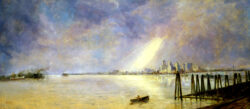George Castleden
Best known for his paintings of New Orleans's French Quarter architecture, itinerant artist George Frederick Castleden held exhibitions in the courtyard of the Cabildo.

Courtesy of Roger H. Ogden Collection
New Orleans Harbor. Castledon, George Frederick (Artist)
The British-born artist George Frederick Castleden was already an accomplished painter when he moved to New Orleans, and he took an active role in the burgeoning French Quarter art community during the 1920s and 1930s. A talented etcher and painter, Castleden found the historic ambiance of the Vieux Carré reminiscent of his childhood in England and an inspiration for his work, which focused on New Orleans’s historic buildings and courtyards, the Old Basin Canal, and the picturesque bayous of southern Louisiana.
Early Life and Art Education
Born December 4, 1861, and raised in Canterbury, England, the young Castleden studied drawing with a well-known local artist, Thomas Sidney Cooper, who had been trained at the Royal Academy in London and whose specialty was paintings of animals. While still a student at the Cooper Gallery, Castleden won a first prize for landscape painting, which encouraged the young man to pursue a career as an artist. He furthered his education at the South Kensington School of Art and attended the annual exhibitions of the Royal Academy in London to keep abreast of current trends and styles.
In 1888, at the age of twenty-seven, Castleden ventured to western Canada, settling in Saskatchewan. He continued his art studies at the Canada Regina Institute. In 1896, at the Territorial Exhibition in Regina, he earned a first prize in landscape oil painting as well as four first prizes and two second prizes in painting; he also won a gold medal in etching at an exposition in Winnipeg. His recognition continued with a first prize at an exhibition of Canadian artists in Toronto.
Between 1896 and 1903, Castleden returned to England and married Fannie Spriggs. Around 1903 he left England to travel as an itinerant scenic painter in America. Fannie remained behind in England; she steadfastly refused to travel with him across the Atlantic.
Life in New Orleans
Castleden visited New Orleans in 1911. The trip clearly made a lasting impression on the artist, but it was not until 1917 or 1920 that Castleden returned to the city and opened a studio at 622 St. Peter Street and maintained a daily gallery in the courtyard of the Cabildo. He joined the talented community of artists and writers in what became known as the French Quarter Renaissance. He was an active member of the Arts and Crafts Club and a charter member of the male-only New Orleans Art League, organized in 1927.
The picturesque sights and historic buildings of the French Quarter captivated the artist. Lyle Saxon, in his “What’s Doing” column for the Daily Picayune newspaper dated October 25, 1925, reported, “George Castleden is still holding his outdoor exhibitions in the courtyard of the Cabildo, and the admirers of the artist’s work say that he has had a busy summer and that his collection of courtyards on display are painted with his customary finesse.” Castleden also published a series of postcards of various views of the French Quarter for the tourist trade. Concerned about haphazard renovations and the possible destruction of the Vieux Carré, Castleden became a dedicated preservationist.
Between 1934 and 1936, Frank Evans, the owner of D. H. Holmes Department Store on Canal Street, commissioned Castleden, with the assistance of fellow artist Mazie Howell, to create a series of paintings for display in the store. The murals largely focused on plantations, bayous, and fishermen’s cabins of southern Louisiana. Seven murals shaped to fit the transoms and niches of D. H. Holmes’s Potpourri Restaurant are now in the collection of the Louisiana State Museum.
In 1935 Castleden spent the summer in Charleston, South Carolina, drawing sketches of the historic city. That same year, he divorced his wife, who had stubbornly remained in England. He remarried and, with his second wife, Louise Decatur, moved to Charleston, in 1936.
In December 1945 Castleden accidently fell at an inn in Abingdon, Virginia. He fractured a rib, subsequently developed bronchial pneumonia, and died at the age of eighty-three. Castleden’s ashes were sent to England for interment at the Canterbury Cathedral.
